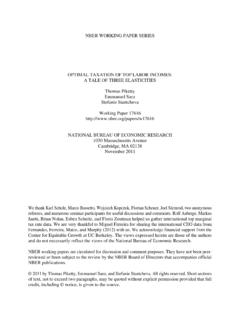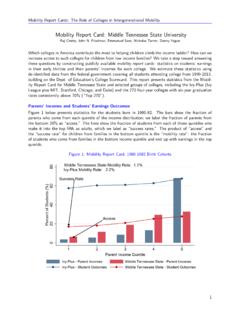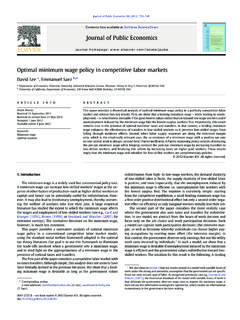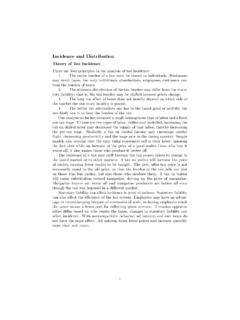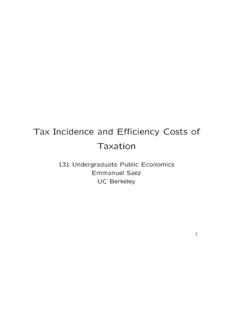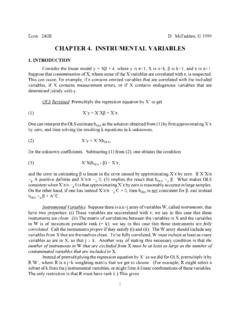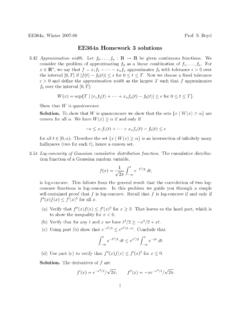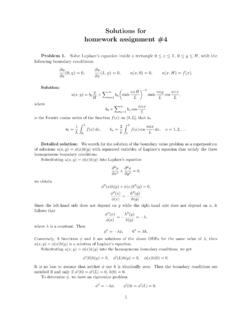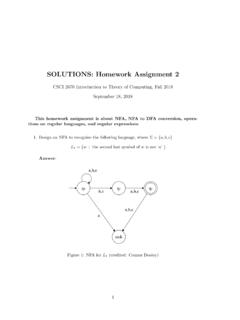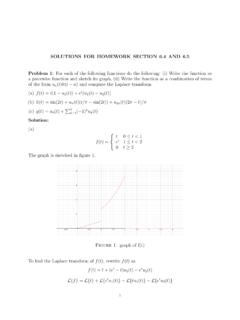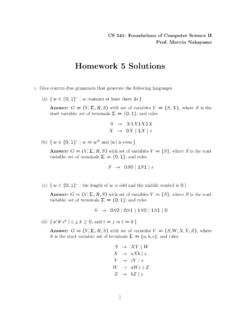Transcription of Economics 181: International Trade Homework # 4 Solutions
1 Economics 181: International TradeHomework # 4 SolutionsRicardo Cavazos and Robert SantillanoUniversity of California, BerkeleyDue: November 21, 20061. The nation of Bermuda is small and assumed to be unable to affect world prices. It importsstrawberries at the price of 10 dollars per box. The Domestic Supply and Domestic Demand curvesfor boxes are:S= 60 + 20PD= 1160 15P(a) Assume Bermuda is Completely open to Trade . What is the equilibrium price and quantityconsumed? How much is produced domestically, and how much is imported?Sine they are open to Trade , the equilibrium price will be determined by the world market. There-fore, using the Domestic Supply and Demand equations, and recognizing that Import Demand isgiven byMD=D S= 1100 35P, we get:Pw= 10D= 1160 15 10 = 1010S= 60 + 20 10 = 260MD= 1100 35 10 = 750(b) Now consider the effect of an import quota of 400 boxes.
2 What happens to the price of straw-berries and quantity consumed?The effect of an import quota is to limit imports at exactly 400. Using the import demandequation expressed above, we can solve for new equilibrium prices to be:400 = 1100 35P Pq= this higher price, we can simply go through the same calculations as before to get:Dq= 1160 15 20 = 860Sq= 60 + 20 20 = 460 MDq= 1100 35 20 = 4001(c) Who wins and who loses? Discuss consumers, domestic producers, and importers (Be sure tocompute the change in their welfare).To answer this, it is useful to look at a 1:Effect of a Strawberry Quota on Bermuda6-QPPw= 10Pq= 20##################Sccccccccccccccccccc DM= 400 ABCDFrom the figure, the welfare affects caused by the quota are clear. First off, the restricted importsallow domestic producers to sell more strawberries at a higher price of$20/box.
3 Therefore,producer surplus increases by area A. Consumers have to pay a higher price, so consumer surplusfalls by the areas A,B,C, and D. Lastly, importers of the good can buy strawberries at the lowerworld price of$10, but sell them for$20, so they gain the area marked by C. The overall impactis a loss of areas B and D. Calculating the areas for each, we have:A=12 (100 + 80) 10 = 900B+D= (750 400) 10 12= 1750C= 400 10 = 4000so the overall welfare loss is: $1, Assume California s supply and demand for beef is:Dc= 800 10 PSc= 200 + 30P(a) Derive and graph California s import demand schedule. If California s agricultural departmentoutlawed purchasing out of state beef to prevent the slaughter of unhappy cows, what wouldthe price of beef be( what is the price of beef in autarky)?
4 California s import demand schedule is given by demand minus supply whenever price is belowthe autarky equilibrium price, orMDc=Dc Sc. This is given by:MDc= 600 40 POutlawing the purchase of out of state beef is equivalent to the case where there is no importdemand, orMDc= 0. From the previous equation, this occurs atP= 15. The demand scheduleis seen in the following 2: Trade Market for Beef Between California and Nebraska6-QPHHHHHHHHHHHHHHHHHHH XSnMDc15311160(b) Now consider Nebraska, with the following demand and supply schedules for beef:Dn= 100 5 PSn= 40 + 15 PExport supply is determined by excess supply above the autarky equilibrium price in Nebraska,orXSn=Sn Dn. This is given by:XSn= 60 + 20 PAgain, the absence of Trade is equivalent to the case with no excess supply, orXSn= 0.
5 Thisoccurs atP= 3. Foreign s export supply is graphed in the above (c) Suppose that interstate sale of beef is permitted between California and Nebraska. What is theworld price? What is the volume of Trade ?If Trade is permitted, equilibrium is determined whereXSn=MDc. We therefore have, 60 + 20P= 600 40P P= a free Trade price of 11, we haveXSn(11) =MDc(11) = 160.(d) What happens if California limits beef imports from Nebraska by adding a 15 percent tax?Calculate the effect of the tariff on (1) the price of beef in each state (2) the quantity of beefsupplied and demanded in each state and (3) the volume of Trade . Calculate the impact on thewelfare of California consumers, producers, government revenue, and total are two things of importance we must notice.
6 The first is that the tariff puts a wedgebetween the price seen in California and Nebraska. Californians now see the Nebraskan priceplus the 15% tariff. The second is that we have to be careful to recognize which price goes intothe import demand and which into the export supply. We therefore get the following system ofequations:Pc=Pn(1 + )XSn(Pn) =MDc(Pc)(1)Using these two equations we can solve for the new equilibrium. Solving for the Nebraskan price,we have:XSn(Pn) =MDc( ) 60 + 20Pn= 600 40( )Pn= 10 Pc= that we know the prices seen in both states, we can solve for each states production andconsumption decisions, as well as the volume of Trade . We get:XSn(10) =MDc( ) = 140Dc( ) = 685Sc( ) = 545Dn(10) = 50Sn(10) = 1904We now have all the information to calculate the welfare effects for California.
7 Below we graphthe effects in California s market for 3:Effect of tariff on California s Market for Beef6-QPPtc= 11 Ptn= 10##################Sccccccccccccccccccc DM= 140abcdeIn the above graph, areaarepresents the gain to producers, areasa,b,c, anddrepresent lossesto consumers, andcanderepresent government revenue. Calculating the areas, we get:a= ( 11) 12(545 + 530) = +d=12 ( 11) (160 140) = 10c= ( 11) 140 = 70e= (11 10) 140 = 140 Overall welfare effects are then given by:consumers : 10 70producers : + : +70 + 140net : +1305 FOR EXTRA CREDIT: Problems 1, 2, 3, and 4 in the Textbook, Chapter Home s demand curve for wheat isD= 100 supply curve isS= 20 + and graph Home simportdemand schedule. What would the price of wheat be in the absenceof Trade ?
8 Import demand is given by the equationMD(P) =S(P) D(P) = 80 40P. The absence of tradeis the equivalent to import demand being zero, which happens atP= 2. The graph is seen 4: Trade Market for Wheat6-QPPPPPPPPPPPPPPPPPPP XS Now add Foreign, which has a demand curveD = 80 20P,and a supply curveS = 40 + 20P.(a) Derive and graph Foreign sexportsupply curve and find the price of wheat that would prevailin Foreign in the absence of s export supply curve is given by:XS (P) =S (P) D (P) = 40 + 40P. The absenceof Trade is equivalent to export supply being zero, which occurs atP = 1. The graph is includedin the above (b) Now allow Foreign and Home to Trade with each other, at zero transportation cost. Find andgraph the equilibrium under free Trade .
9 What is the world price? What is the volume of Trade ?When they are allowed to Trade , there is no distortion in prices so we have a common worldprice ofPw=P=P . In order to find equilibrium, we set import demand equal to exportsupply giving:MD(P) =XS (P ) 80 40Pw= 40 + 40Pw Pw= this world price we haveMD( ) =XS ( ) = Home imposes a specific tariff of on wheat imports.(a) Determine and graph the effects of the tariff on the following: (1) the price of wheat in eachcountry; (2) the quantity of wheat supplied and demanded in each country; (3) the volume tariff causes a wedge to be placed between prices seen between the two countries, so we nowhaveP=P + 5. Setting export supply equal to import demand, we get:MD(P + 5) =XS (P ) 80 40(P + ) = 40 + 40P P = P= these prices production in each country is given by the following:Table 1: Quantity of Wheat Supplied and Demanded in Each (P= )5565 Foreign (P = )6555 The volume of Trade is given by:MD( ) =XS ( ) = 10 The effects on the Trade market are given in the graph 5: Trade Market for Wheat with a tariff6-QPPPPPPPPPPPPPPPPPPPPPPPPPPPPPPP PPPPPPPP P= = t(b) Determine the effect of the tariff on the welfare of each of the following groups: (1) Homeimport-competing producers; (2) Home consumers.
10 (3) the Home import-competing producers are better off because they have less foreign competition, whichmeans both price and quantity of good produced domestically increases. Home consumers areworse off because they now have to pay a higher price. The home government benefits in thatthey now have additional tariff revenue.(c) Show graphically and calculate the terms of Trade gain, the efficiency loss, and the total effecton welfare of the 6:Terms of Trade Gain and Efficiency Loss for Large Country with ##################ScccccccccccccccccccDa bcdeefficiency loss: (b+d)terms of Trade gain:eM= 10 8 From this figure we can see the areas that were referred to in the answer to part (e). Producersgain area a, consumers lose areas a, b, c, d, and the government receives tax revenue c and can calculate the areas with some simple geometry.

